4th General Hospital Unit History
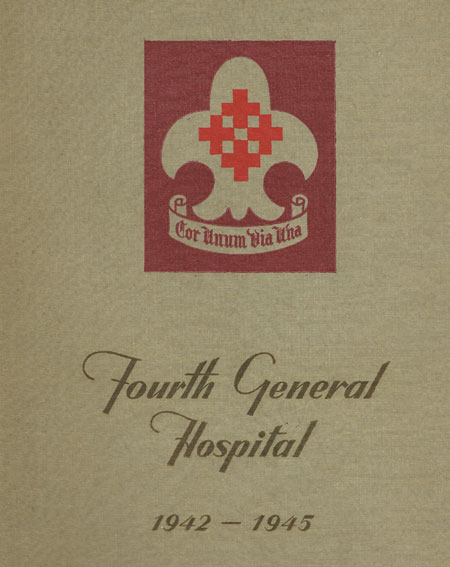
Printed cover of the 4th General Hospital’s Unit History showing its Distinctive Unit Insignia.
Activation & Training:
The 4th General Hospital can trace its roots back to the service of Base Hospital No. 4 during WW1. After having been organized at Lakeside Hospital, Cleveland, Ohio, it was mobilized in 1917 and moved to New York, whence it sailed 5 May 1917 for the United Kingdom, arriving at Liverpool 17 May of the same year. The unit crossed into France on 24 May 1917. It operated with the British as No. 9 Lakeside US General Hospital, British Expeditionary Forces. Although the unit did not earn any battle honors while in France, it was entitled to credit for service in France from 24 May 1917, to 11 November 1918. On 8 August 1936, Base Hospital No. 4 was reconstituted and consolidated with the 4th General Hospital (an organized reserve unit since 1 March 1923). The unit had originally served with the American Expeditionary Force, and was inactivated at the close of the conflict in Europe. However, a letter dated 8 August 1936 gave a recapitulation of the functions of the Hospital under the new title of the 4th General Hospital which had been constituted on 1 October 1933 at Fort Jackson, Columbia South Carolina (Infantry Training Center -ed). The 4th General Hospital was subsequently withdrawn from the organized reserves and allotted to Fifth Corps Area, as a Regular Army inactive unit, effective 1 October 1933, pursuant to Letter, War Department, Adjutant General (320.3), 16 August 1933, dated 18 August. In the spring of 1940, Dean Sollman of the Western Reserve School of Medicine received a letter from the US Surgeon General requesting the establishment of a medical unit with a professional staff to be selected from the medical school faculty and staffs of associated hospitals. Authorization was received from the Adjutant-General and the selection of professional personnel was begun. Official activation was authorized pursuant to Letter, War Department, dated 13 January 1942.
Around the same time, hundreds of men destined to become members of the Hospital Detachment entered the Army. Assigned to the Medical Corps they began to learn how to handle X-ray film, pipettes, medical records and all the other paraphernalia of a military hospital.
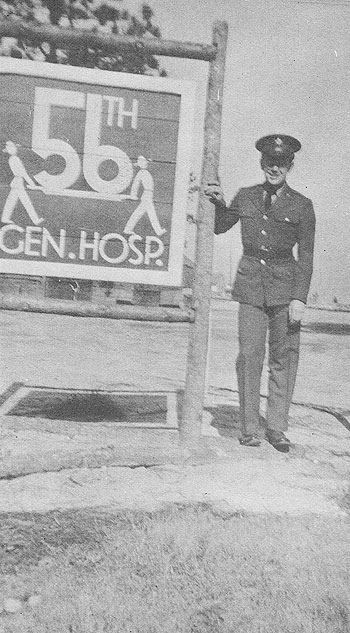
Unidentified member of the unit stands in front of the entry sign to the 56th General Hospital at Fort Jackson, South Carolina. January 1942.
On 24 December 1941, a telephone call from the Office of the Surgeon General to the unit director in Cleveland offered to the 4th General Hospital the opportunity to become the first General Hospital to be sent to foreign duty in World War II. It was pointed out that this would allow the unit to follow in the footsteps of its illustrious predecessor. The opportunity was eagerly accepted, and between 6 and 8 January 1942, final type physical examinations were done on Officer and Nurse candidates. Special War Department Order No. 8 (9 January 1942) ordered the Officers of the unit to active duty at Fort Jackson, South Carolina.
Upon arrival at Fort Jackson, the Officers of the newly activated unit met the personnel of the 56th General Hospital which, for almost a year, had worked together with the members of the 4th in both military and medical training programs. On 13 January 1942, by General Order No. 3 the two units were merged into a single group under the designation of the 4th General Hospital under the command of Colonel Frank Starnes, while Lt. Col. William C. McCally assumed the role of Chief of Surgery (and would later become the unit’s Commanding Officer –ed).
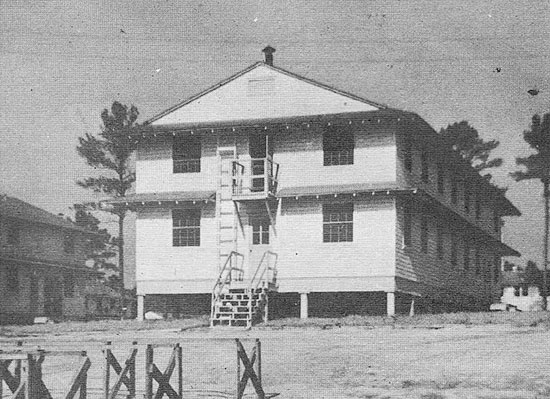
Illustration showing the barracks inhabited by the Hospital’s staff at Fort Jackson. January 1942.
On 16 January the entire group entrained for Indiantown Gap Military Reservation Pennsylvania (Training Center -ed). While there, the complement of Enlisted Men was filled to strength by the addition of a large group from Camp Lee, Petersburg, Virginia (Army Service Forces Replacement Training Center –ed). The stay at Indiantown Gap was fortunately very brief and was characterised by snow, mud, bologna sandwiches, midnight photography and fingerprinting. On the night of 19 January all personnel were loaded on board an old Reading train and reached the port of embarkation the following morning.
Preparation for Movement Overseas:
In the early dawn of 20 January 1942, the unit filed up the gangplanks of the transport ships “Thomas H. Barry” and “John Ericsson”. On 13 January, 72 Nurses from the Cleveland area had been accepted and they were ordered to the Port of Embarkation on 16 January. Their numbers were augmented by 48 more transferred from ten other military hospitals in the eastern states. On 20 January they boarded the transports too, many still in civilian dress.
After formation and assembly at New York P/E, the convoy left on 23 January 1942 with an escort of destroyers for an undisclosed destination.

Nurses from the Cleveland area prepare to board the transport ship for movement overseas.
During the days that followed, rumor was rife, and had the unit sailing to practically every port on the globe. Finally, on the morning of 23 January the line of grey ships slipped by the channel buoys of the New York harbor with an escort of warships, blimps and aircraft.
During the journey to the Pacific, very meagre daily bulletins brought news of the fall of Singapore and the SS “Normandie” disaster. Time was passed in reading, sun bathing, marathon card games, dominoes (galloping), standing in chow lines and speculating on possible ports of disembarkation.
Australia:
On the morning of 26 February 1942 the coast of Australia was visible and the convoy was greeted by planes bearing the unfamiliar markings of the Royal Australian Air Force. Debarkation came on the following day after 37 days aboard the two transport ships. Officers and Enlisted Men were sent to Royal Park, where a large military encampment was under construction. They were quartered in huts and tents and soon became fully acquainted with dust, sand fleas, icy shower baths and “Weetbix.” The Nurses were scattered in various billets in the city hotels.
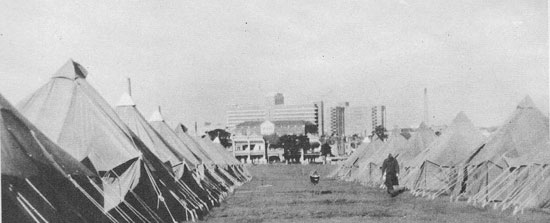
View showing two rows of Pyramidal tents at the Royal Park facility.
On 15 March 1942 it was learned that the new Royal Melbourne Hospital, which was still under construction, was to become the first permanent installation of the 4th General Hospital (under Reverse Lend-Lease conditions –ed). Plans were initiated for its expedited completion as the need for a large hospital was growing daily. The impressive group of buildings situated at the head of Elizabeth Street was designed as a General Hospital and was also provided with very adequate teaching facilities. The group consisted of five units: the main building with the Walter and Eliza Hall Research Institute attached, the Nurses’ apartments, the resident Medical Officers’ home, the heating plant, and an animal house. As rapidly as construction could be completed and equipment installed the hospital was made ready. The first portion to be prepared was the lower floors of the Nurses’ home. On 6 April 1942 the first patient was admitted and given register number ‘1’.
By 12 May the first of the wards in the main building was occupied. Meanwhile the temporary arrangements in the Nurses’ home had been taxed to capacity. The other wards and departments were also gradually put into operation and within a few months the entire Hospital was ready for use at full capacity. It is interesting to know that Mrs. Jean MacArthur and 4-year old son Arthur were briefly admitted for observation at the 4th General Hospital, following their escape from Corregidor Island on 11 March 1942.
For several months, the Detachment was quartered in Pyramidal Tents in Royal Park. In August 1942, permission was obtained to use the football oval of the adjacent University High School as a Detachment area. Metal huts were constructed and outfitted as barracks, mess halls, kitchens and a day room. The new barracks were well received by all Detachment staff, and were a marked improvement over the floorless tents in Royal Park. Double-deck bunks were used to provide more floor space and certain wings were reserved for personnel on night duty. When the peak load of patients was being carried, it was necessary to use two of the barracks as wards. Pyramidal Tents were put up beside the RMO to accommodate the men who had to be moved out.
The day room was equipped with writing tables, a radio, comfortable chairs, a ping pong table, and a billiard table. This last, during the first few days of each month, was taken over for a modified form of parchessi.

Illustration showing the group of buildings used by the 4th General Hospital.
Detachment activities both intra- and extra-curricular were numerous and varied. Duty hours were filled with work of the hospital, classes for advanced instruction, and military routines. During off-duty hours there were a minimum of restrictions and a man’s activities were usually limited only by his enterprise! The unit’s basketball and volleyball teams rose to the top of the heap by winning regularly from the outside competitions. Softball, tennis, riding and fishing were also popular pastimes among the Hospital’s personnel.
The unit’s newspaper, “The Mortem Post” made its introduction as a mimeographed sheet on 26 June 1942. In Melbourne it was published weekly, in New Guinea daily. Throughout the unit’s service, the paper underwent many changes but always remained full of local color and interest. The “Mortem Post” was published through the courtesy of Lt. Colonel William McCally, Commanding Officer and with the help from T/Sgt. Carnahan (Editor in Chief), Cpl. Bonham (Editor), Maj. Lazzari & Chaplain Demmel (Consulting Editors), Chaplain Masin (Managing Director), 2d Lt. Rutan (Nurses’ Editor), S/Sgt. Minsavage (Patients’ Editor), Sgt. Chatterton (Sports Editor), T/5 Sunshine, Pvt. Denis, Pvt. Greene, (Associate Editors), and Sgt. Lyon & Pvt. Johnson (Staff Artists).
As the hospital expanded it soon became evident that a rehabilitation center was needed for the reconditioning of patients. After prolonged hospitalization the soldiers’ greatest need is graduated exercise, in healthful surroundings. A boys’ camp owned by the Melbourne YMCA located near Frankston was acquired for this purpose. Situated on the ocean shore with all facilities for bathing and other sports, it not only served as a rehabilitation center, but also was used by the Detachment for rest and recreation.
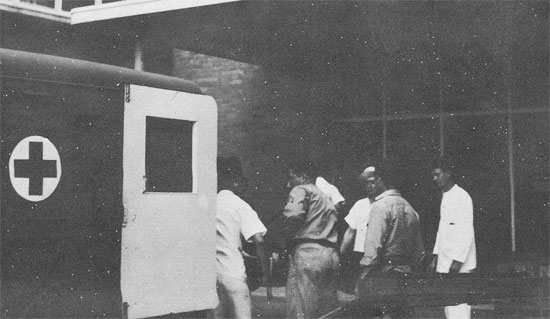
Patients are unloaded by Hospital personnel from an Australian ambulance.
With the extensive facilities of Melbourne at hand, there was little need for provision of entertainment for ambulatory patients. For those whose physical condition precluded passes to town, various diversions were provided. The American Red Cross conducted art classes, ran a well-equipped craft shopped and provided a variety of games and entertainment. The occupational therapy department created useful and active pastimes for many idle hours. The Chaplain and Special Service organized the library, provided movies and indoor and outdoor entertainment.
The amphitheater of the hospital, which had originally been designed for medical lectures, was converted into a theater. Although limited in size, it provided a very adequate place for the showing of movies and camp shows. During the day and in good weather a large concrete courtyard situated in the rear of the hospital complex was also used for entertainment and shows. It accommodated many more people and the stage could be seen from the balconies where bed patients could be wheeled from their wards.
During the second year in Melbourne, a seaside estate was leased for the summer at Sorrento (approximately 60 miles from the hospital). Staffed by US Army personnel it was a superb place for rest and recreation in most pleasant surroundings. Swimming, boating, fishing, tennis and golf were all on the program. A large group of Nurses from New Guinea for recuperation also took full advantage of the complex.
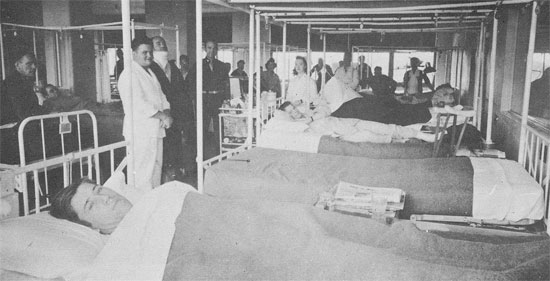
General view of the surgical ward at the Elizabeth Road complex.
The activities of the Officers during the Melbourne period were also very diverse. An immediate liaison developed between the Medical Officers and their Australian confrères. In the early days at the complex when equipment was incomplete, laboratory and other facilities were put at the unit’s disposal by metropolitan and other military hospitals in the vicinity. In addition, the physicians of the 4th Gen Hosp also held a formal medical meeting once a month whilst in Melbourne.
In September 1942, the personnel for two 25-bed Portable Surgical Hospitals was selected. These units underwent additional, intensive training to fit them for the type of work which was to be on the front line. Each unit comprised 4 Officers and 25 Enlisted Men. Each man took an active part in the early phases of the New Guinea campaign and was eventually returned to the 4th for rest and rehabilitation. Eventually, the second Portable Surgical Hospital took over the AHS “Tasman” (under Dutch Flag, crewed by Dutch Officers and Javanese crew, but under control of the Australian Government -ed), while the first Portable Surgical Hospital was reformed and again went into the field in September 1943.

The unit’s baseball team prepares for one of its matches against the local Australian team.
During the 23 months that the 4th General Hospital was located in Melbourne, over 35,000 patients were admitted. The procession of sick and wounded included soldiers, sailors, marines, merchant seamen, evacuees from the Philippines and East Indies, as well as civilians of various nationalities. Patients were received by ambulance, Hospital Train, Hospital Ship and plane. Daily admissions peaked on 23 June 1942 when they reached 700. For several weeks following this date, daily admissions numbered between 100 and 150.
Whilst in Melbourne, the 4th functioned as both a Station and a General Hospital.
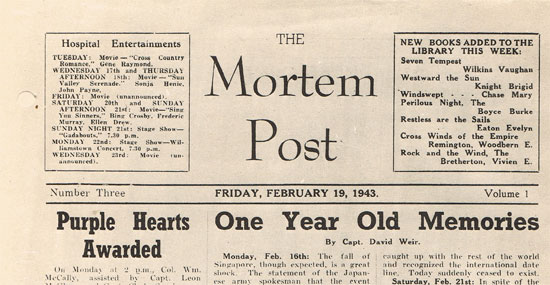
Headlines from the 19 February 1943 edition of “The Mortem Post”, the unit’s official newspaper.
As the combat zone was pushed forward the evacuation of sick and wounded as far south as Melbourne became impractical. Early in 1944 it became apparent that the 4th would soon be moved to a forward area. Wardmen and Technicians became packers, and within a short time all moveable equipment had been crated ready for the next move. Finally, the remaining patients were turned over to the 89th Station Hospital which had taken over the Detachment area as a hospital site.
New Guinea:
Orders were received on 21 March 1944 for the unit to be moved to Finschhafen, New Guinea. An advance party of Officers and Enlisted Men had already travelled to the area to locate a suitable location for the Hospital. The actual movement of the unit began on 22 March 1942 when the first personnel and equipment departed the station at Melbourne for the port of Brisbane. In Brisbane, the Officers and Enlisted Men were quartered at Ascot and the Nurses were sent to Camp Columbia for staging. After several days of anxious waiting, all personnel and equipment was finally loaded aboard the SS “Alcoa Polaris”, which departed from Brisbane on 25 March 1944. Aside from rough waters the voyage was largely uneventful. Stops were made at Townsville, Milne Bay and Oro Bay, before the liner arrived and dropped anchor in Port Moresby on 14 April.
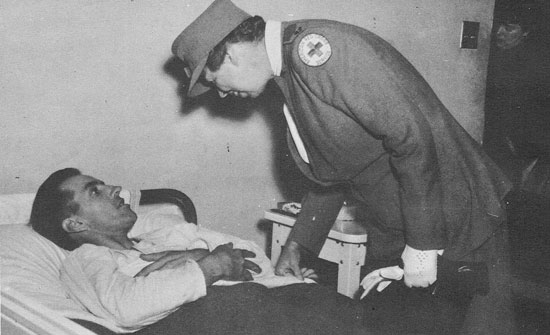
First Lady Eleanor Roosevelt visits a patient on the ward of the 4th General Hospital.
Early impressions of Finschhafen included rain, mud, dust, heavy machinery and broken water pipes. The hospital area had formerly been a Japanese airfield, so it was reasonably level and ready for construction. By the time the 4th arrived most of the construction for a 500-bed unit had been completed. During the weeks that followed, there was much more carpentry than orthopedics, and more plumbing than urology! By 23 April 1944, nine days after landing, the first shipment of casualties was received.

Aerial view of the completed 500-bed unit at Finschhafen. April 1944.
As rapidly as new wards could be made ready, patients arrived to fill them. There was gradual progress from a miscellaneous collection of buildings to a well-ordered, integrated hospital complex. Also utilizing the site and assisting with the necessary construction work were the 161st Station Hospital and the 126th Station Hospital.
As the months passed, the efficiency of the various departments increased until the whole organization was running as smoothly as it had in Melbourne. Shortages of supplies were corrected, bulldozers stopped tearing up the water mains, and adequate power units were installed to run all of the equipment. Personnel became accustomed to the climate and were surprised to find it not unpleasant. Multi-colored lizards, land and hermit crabs, rats, bandicoots and occasional snakes were seen around the complex. Thanks to malaria control mosquitoes were few and far between.
On 1 October 1944, orders were received for the 63d and 126th Station Hospitals to be merged with the 4th General Hospital. The buildings of the 126th Station Hospital continued to be used for several months, and were known on-site as South Area. In May 1945 a small hospital unit known as Ward 25 was established at the airstrip using the old buildings then redundant. This small hospital was equipped to carry out emergency surgery and take care of patients needing only a few days of hospitalization.

Signpost of the 4th General Hospital at the converted airfield in New Guinea.
In total, the complex at Finschhafen was capable of housing 2,000 patients at any one time. This limit was tested several times during the unit’s stay there, sometimes exceeding it by a few hundred. While at the facility, approximately 11,200 patients were admitted. The unit admitted more surgical patients at Finschhafen than it had in Melbourne, as well as numerous medical and psychiatric cases.
Philippines:
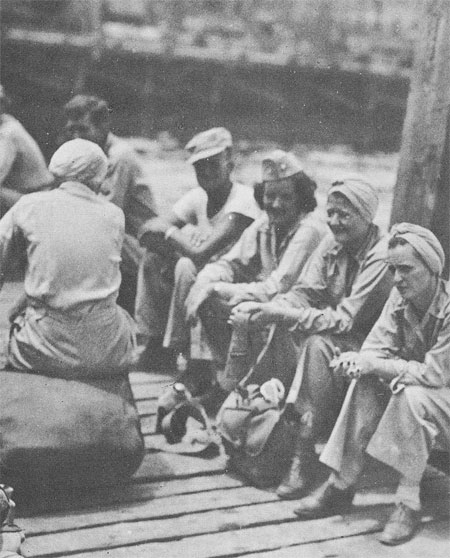
Female personnel of the 4th Gen Hosp prepare to board troopships to take them back to the Zone of Interior for discharge.
The Hospital at Finschhafen was officially closed on 23 July 1945, and all personnel from the unit were alerted for movement to Manila, Philippine Islands. However upon arrival in Manila, the Japanese had meanwhile surrendered and further action by the unit was deemed unnecessary. As a result, it was planned to inactivate the 4th General Hospital while it was stationed in Manila. The situation gradually affected other hospital units operating in the Philippine Islands, such as the 120th General Hospital (Santo Tomas University), which closed down 28 November 1945, after transferring the majority of its personnel to the 4th General Hospital.
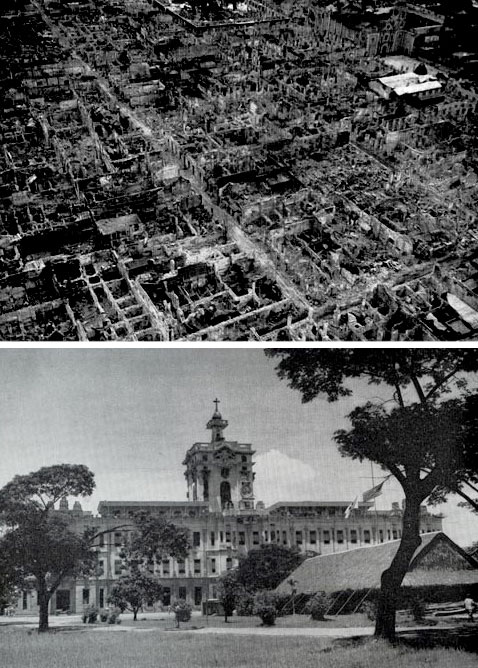
Apparently the 4th General Hospital remained in the Philippines until October 1946. There is proof that additional servicemen joined the organization at Baguio, Northern Luzon, APO # 1105, as late as August 1945. At the time, Colonel Van Wagoner, MC, was the Commanding Officer.
As far as the authors know the 4th General Hospital left the Philippines 7 October and returned to the United States on 21 October 1946. A number of service personnel were honorably discharged at Camp Beale Separation Center, Marysville, California (Division Camp; acreage 86,364; troop capacity 2,107 and 35,228 Enlisted Men –ed).
Unit Roster (incomplete):

Photograph showing entire Officer personnel of the 4th General Hospital. Manila, 1945.
Unfortunately the following roster, taken from the 1945 published Unit History of the 4th General Hospital is incomplete and mostly includes only surnames. The authors would be grateful for any assistance in fully identifying the personnel listed here…
Officers:
| Allen |
Glenn (Capt) |
Mountain, Bob (1st Lt) O’Brien (Maj) |
| Ambrose |
Hamann, Carl A. (Maj, O-403191) |
Myers, William T. (Capt) |
| Benton, Marion L. (Capt) |
Hanger (Maj) |
Pedicini |
| Blandford, Sidney E. (Maj) |
Hardwig, Robert P. (1st Lt) |
Pratt, William N. (Capt) |
| Blix, Fred M. (Capt) |
Harper, Edward O. (Maj) |
Read |
| Bottalico, Michael A. (Capt) |
Huff, Stanley E. (Capt) |
Rundell |
| Brackett (1st Lt) |
Jordan |
Sabik |
| Bricken, William M. (1st Lt) |
Kahn |
Servis (Capt) |
| Briggle (1st Lt) |
Kauffman |
Slipakoff (1st Lt) |
| Bronson (Capt) |
Kelly, Donald A. (Maj) |
Solomon, Walter M. (Maj) |
| Brown (1st Lt) |
King |
Sullivan |
| Brugler, Guy W. |
Lenhart, Robert L. (Capt) |
Taylor, Alva R. (Capt) |
| Chamberlain |
Leoff (1st Lt) |
Thornton, John J. (Maj) |
| Couch (1st Lt) |
Lusk (Chaplain) |
Tichy |
| Cox |
Markley, William W. (1st Lt) |
Tomaro, A.J. (Capt) |
| Demmel, Clyde (Chaplain) |
Masin (Chaplain) |
Wagoner, Van (Col) |
| Donnelly |
Maurer |
Walzer, J. |
| Dybdahl, Chris J. (1st Lt) |
McCally, William C. (Col, CO) |
Walzer, L. |
| Eichhorn |
McDonald |
Wartman |
| Elkins (Capt) |
McGaw (Maj) |
Webster (Capt) |
| Ferreri, Edward (1st Lt) |
McGlynn (Capt) |
Weir, David A. (Capt) |
| Foltz (Capt) |
McKay |
Wexkesser |
| Friedman |
McKeown (Chaplain) |
White, Edward A. (1st Lt) |
| Gernon Gray, Ralph E. (Capt) |
Meschan |
Workman |
Nurses:
| Allison |
Hamiter Hanes, Gladys |
Mesko |
| Amidich |
Hanninen |
Morin Moss, Nancy (1st Lt) |
| Barbour |
Haskagen, Jane |
Mramor, Juel (Capt. – KIA) |
| Beal |
Herren |
Murch |
| Benderoff, Olga O. (Capt, Chief Nurse) |
Hicks, Helen E. (2d Lt) |
Murphy |
| Benton |
Hoel, Stella E. (Capt) |
Nevis, Helen |
| Bogle |
Hoff |
Norris |
| Bowen |
Horn |
Oftedahl |
| Boyer |
Howell V. |
Onley |
| Boyle |
Iannota |
Phillips |
| Brennick (2d Lt) |
Ingram, Jane |
Polofsky |
| Cadiss, Ethel |
Jerome |
Priest |
| Carter, V. |
Johnson |
Reyser (1st Lt) |
| Chapman |
Jones |
Robinson |
| Chilson |
Jordan |
Rollins |
| Clarke |
Kane |
Rothschild |
| Cowan |
Kaufman |
Rothstein |
| Culbertson, Ely |
Keyser, Edith |
Rowand |
| Darmody, Helen (1st Lt) |
Kieselbach |
Rutan, E. (2d Lt) |
| Dee |
King, Olive P. (1st Lt., N-722217) |
Schlabach |
| Deeds |
Kinzeler, Ruth L. (Capt) |
Scott Ernestine |
| Dixon, Ann |
Kirkpatrick (1st Lt) |
Simpson |
| Donley |
Klinko |
Sisson |
| Durr, Bernie |
Kmet |
Smather, Helen |
| Ely |
Kolinska Babs |
Smith, J. |
| Ficzeri |
Kublic |
Sokol |
| Fitzsimmons |
Kusek |
Stein |
| Foley, Ann |
Langan, Josephine (2d Lt) |
Stime |
| Forshey |
Lewis (2d Lt) |
Stoney |
| Frisch, Dotty |
Lindquist |
Tampson (1st Lt) |
| Gagnon, E. |
Locke (2d Lt) |
Thomas |
| Gagnon, J. |
Lockhart, Hazel |
Turner |
| Geib |
Mahin |
Walsh |
| Gierisch |
Malko |
Ward |
| Gill Essie |
Malone, Molly |
Wassel |
| Gill J. |
McCord |
Weeks |
| Gold |
McCoy |
Woodbury |
| Gruber |
McCullough |
Yamnick |
| Haas |
McInerney (2d Lt) |
Zelm |
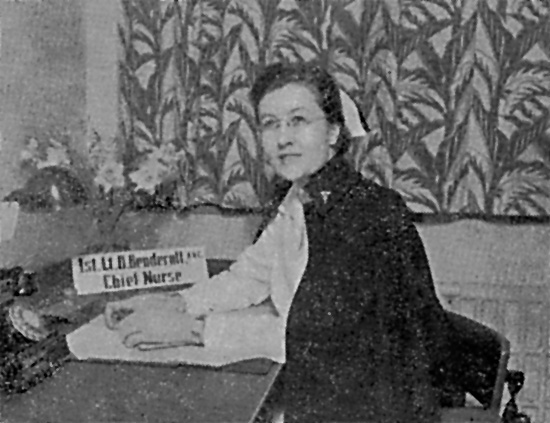
Photograph of 1st Lieutenant Olga O. Benderoff in the ZI (previously Assistant Director of Nursing, University Hospital, Cleveland, Ohio) in charge of recruiting Nurses for the reserve group activated in January 1942.
Physiotherapists & Dietitians:
| Bolton |
Lovett, Gilda M. (Capt) |
Spencer |
| Bovee |
Marshall |
Teale, Leah E. (1st Lt) |
| Clement |
Rice |
note: a number of Australian and New Zealand civilian personnel were hired by the 4th General Hospital (and by other US Hospitals stationed in Australia). They were Pratt Nance (Dietitian), Alt Margaret, (Physiotherapist) and Langley Doreen M. (Dietitian). Although officially in service, the women never obtained a commission as Second Lieutenants.
Enlisted Men:
| Adams |
Helverson |
Reinke |
| Adkins Bob (Sgt) |
Henricksen Hermandez |
Reiss |
| Aiello |
Hess |
Remien |
| Albee |
Hettman |
Remy (Sgt) |
| Aldridge |
Hietala |
Reyes |
| Alexander |
Hill Howard (Pfc) |
Richardson |
| Allen |
Hoffman A. |
Rim |
| Alvarez Frank |
Hoffman B. |
Rinersma |
| Anastasi |
Hohweiler |
Rinko |
| Anderson |
Holt Carl |
Rivera, Albert E. (T/5) |
| Angeloni |
Horning Russell |
Roach James (Pfc) |
| Angi |
Hubina |
Roark |
| Arner |
Huckell |
Roberts |
| Arrich John (M/Sgt) |
Hutchins Clifford (Pfc) |
Robinson Irwin |
| Arvia |
Hutchinson |
Roche |
| Ashenfelder |
Iler |
Rosales, Victorino V. (T/5) |
| Atamanec |
Ince |
Rosenthal Theodore (S/Sgt) |
| Aylward Bill (S/Sgt) |
Jack |
Rotkowitz |
| Azoff |
Jacklin |
Rubas |
| Bakey |
Jackoby |
Rugala Alexander (Cpl) |
| Baldi |
Jackson |
Russel |
| Barbee |
Jacobs |
Ryan |
| Barnes E. |
Jarman |
Ryczkowski |
| Barnes W. |
Johnson H. |
Sabeswitz |
| Barnett O. |
Johnson R. |
Sado |
| Baron |
Jones |
Samaras |
| Barrick F. |
Judge Bernard F. |
Santino |
| Barrick L. |
Kalston |
Santora |
| Bartlett |
Kasner |
Saslo |
| Barzydlo |
Keathley |
Saums |
| Basis |
Keegan Jim |
Scaman |
| Bauman |
Killinger |
Scarborough R.O. (Pfc) |
| Beardley |
Kinkel |
Scarpa |
| Beck |
Kirk |
Schein |
| Behrens |
Kozarsky |
Schiavone |
| Beiter |
Kraft |
Schuh |
| Bennett (T/Sgt) |
Kuba |
Serbus |
| Bensky |
Kunze |
Serpico |
| Bernabai |
Landry |
Serraino |
| Bernstein |
Lariviere Germain (Pvt) |
Shannon (Sgt) |
| Bertino |
Leitner |
Sharp |
| Biondo Don |
Lesko |
Shelby |
| Blumberg |
Lesosky |
Sheppard |
| Bobyock |
Lester |
Sherman |
| Bonham (Cpl) |
Levernson |
Shrodes |
| Bouslog |
Levine |
Siciliano |
| Bousquet |
Levison |
Sierfert |
| Bowen |
Levy |
Sigmund |
| Boyd |
Liebiedz |
Simon Earl C. (1st Sgt) |
| Branch Orvaldane (Pfc) |
Light |
Sloane Dave |
| Breon |
Lister, Richard C. (Cpl) |
Smith D. O. |
| Briley |
Lombardo |
Smith D. |
| Brodley |
Long |
Smith J. H. |
| Brooks |
Loving |
Smith J. V. |
| Brown, George (T/5) |
Lucian J. |
Smith, Melton E. (T/5) |
| Budke |
Lucian Nick (Cpl) |
Smothers |
| Caloia |
Ludwig Robert J. (M/Sgt) |
Snell |
| Camp |
Lyon (Sgt) |
Snyder Ken |
| Cardianle |
MacIntyre |
Sobel |
| Carnahan (T/Sgt) |
Maginsky |
Soito |
| Carney |
Maholick |
Solomon E. |
| Carratura |
Mahtern |
Solomon M. |
| Carroll |
Manfredi |
Solot |
| Casella |
Maraggioglio |
Somerset |
| Caster Milton (T/4) |
Marchant |
Somyk |
| Caudle |
Markle, L. C. (T/5) |
Soresino |
| Ceuleers |
Marschke |
Sorkowitz |
| Chamlee |
Martin |
Soroka Mike |
| Champion |
Massengill |
Sorrells |
| Chandler |
Matarese |
Spallone |
| Chatterton Frank (Sgt) |
Matuska |
Speeney |
| Chinnici (Sgt) |
Mauriello |
Spencer |
| Chmurski |
Maxwell |
Sprowle |
| Cicarelli |
McDermott (Sgt) |
Squire |
| Clark F. H. (Pfc) |
McGuire |
St. Dennis |
| Coffone |
McPherson |
Staggs |
| Colbert |
McWilliams |
Stansell |
| Cole |
Micek |
Stawinksi |
| Connell |
Milburn |
Stephens J. |
| Cox M. |
Miller F. |
Stephens T. |
| Cranfill H. K. (T/4) |
Miller H. |
Stewart |
| Craven Keith |
Miller J. |
Stones |
| Cunningham |
Mingins |
Stretch |
| Czerniak |
Mings |
Strickman |
| Damas |
Minkwitz |
Strizzi |
| David John (Pfc) |
Minnich |
Stroud |
| Davis, Isaac (Cpl) |
Minsavage (S/Sgt) |
Stuart |
| Davison, Charles C. (T/5) |
Mobley |
Stumpf |
| Daylie E. B. (Sgt) |
Moldrawski |
Sullivan R. |
| De Petrillo |
Moncelsi |
Sullivan S. |
| DeLain Jack |
Moniak |
Sundquist |
| DeSalvo |
Moravek |
Sunshine (T/5) |
| Debruin R. P. (Sgt) |
Morawsky |
Swan Hilbert |
| Dela Vega Pedro M. (T/5) |
Morgan, James B. (Cpl) |
Sykes |
| Delgado |
Morgenegg |
Sylvester |
| Demperio |
Mosberg |
Symczyk |
| Dennis (Pvt) |
Moss |
Taylor (Pfc) |
| Depatrillo (Sgt) |
Muehling |
Teague |
| Devine |
Muldoon |
Thomas B. |
| DiScala (Pfc) |
Munn |
Thomas C. |
| Dinublio |
Mussfeldt Gordon (Pvt) |
Thomas J. |
| Dishroon, James A. (T/5) |
Muñoz |
Thompson |
| Dodson |
Myers |
Tluczek |
| Dominas |
Mykietyn |
Toroni |
| Dragoo |
Nichols A. |
Tortorella |
| Drybeard |
Nichols G. |
Trebissacci (Cpl) |
| Dunn |
Nielsen Dan |
Tripoli |
| Eccles (Sgt) |
Nizin (T/Sgt) |
Trzeciakiewicz |
| Elliott |
Norris |
Tucker Homer |
| Ellis D. |
Nowariak |
Valerie Mike |
| Ellis L. |
Nye |
Van Keuren |
| Erwin |
Oberlin |
Van Volkenburg |
| Eshelman |
Ogozalek |
Vander Honing |
| Farenski |
Olsen |
Venuto |
| Faul Greydon A. (T/5) |
Onkst |
Vineyard |
| Fehn |
Overstreet |
Wacker |
| Ferguson |
O’Brien |
Walker |
| Ferris W. |
O’Neill |
Wallace |
| Fessler |
Paonessa |
Wambold Horace (Pfc) |
| Fields Leslie |
Parr |
Ward |
| Fila |
Parsons, William Q. (T/5) |
Warford |
| Finn |
Pawlak |
Washington |
| Fitzpatrick |
Payne |
Watson |
| Flom |
Pearson |
Weaver |
| Forrest |
Peleko, Joseph K. (Cpl) |
Webb |
| Fried |
Penesis |
Weddle |
| Frye Charles F. (T/4) |
Penso |
Welborn Bob |
| Fulton |
Percival |
Wells |
| Garcia, José M. (T/5) |
Peterson, Boyd (Cpl) |
Werner |
| Gateman |
Petrone |
West, James A. (T/5) |
| Gies |
Phillips W. A. (M/Sgt) |
Whealin Dan (Sgt) |
| Gildersleeve Gabby |
Pike |
Wheatley |
| Giles |
Pitera |
Wheelis |
| Gittins |
Pletcher |
White Ashton H. (Cpl) |
| Gizzi Al |
Poethke Carl |
Wilhelm, Roman J. (Cpl) |
| Glatzl, Francis J. (T/5) |
Polak |
Willey, Adrian V. (T/5) |
| Grant |
Pratt |
Williams C. A. |
| Gray John |
Pridmore |
Williams C. F. |
| Gree S. |
Pryslak |
Williams C. W. |
| Greene (Pvt) |
Pugh |
Williams Homer |
| Groh |
Queenan |
Williams J. |
| Gross |
Rae |
Williams Lloyd |
| Groves |
Rafferty |
Williamson |
| Gunther |
Ralph |
Witmer |
| Haase |
Rank Richard |
Witt Jack (Pvt) |
| Hackney |
Raucjer |
Woodford |
| Haggmark |
Reday (Pfc) |
Wortman Joe |
| Hampton |
Redd (Pvt) |
Yanyanin |
| Hancock |
Reece |
Yerton |
| Hansen |
Reed |
Young A. |
| Hartman |
Reel |
Young E. |
| Hatt |
Reid G. |
|
| Hattem |
Reid H. Reinhardy |
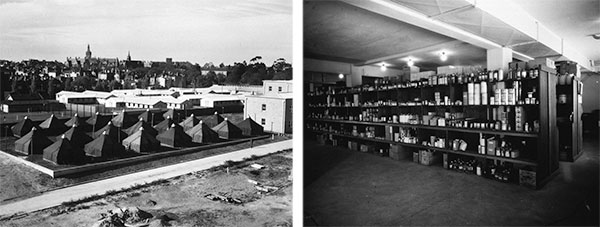
4th General Hospital in Australia. Left: partial view of the Hospital’s initial setup at the Royal Park, Melbourne. Right: Inside view of the Hospital’s Medical Supply Room, at the Royal Melbourne Hospital.
The MRC Staff wish to sincerely thank the Patricia Lesslie Family, Canberra, Australia for providing them with several photocopies of the 4th General Hospital “The Mortem-Post”. They also want to acknowledge the kind assistance received from Dr. Rosemary Annable, Sydney, Australia + Derbyshire, England. Thank you so much. Additional thanks are due to Justin Smith, grandson of Technician 5th Grade Melton E. Smith (ASN:35970817) who served with both the 120th General and the 4th General Hospital in the Philippines.
